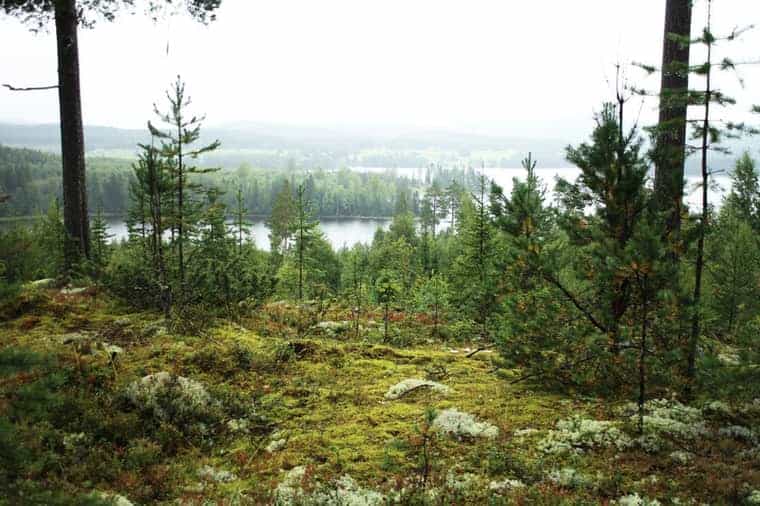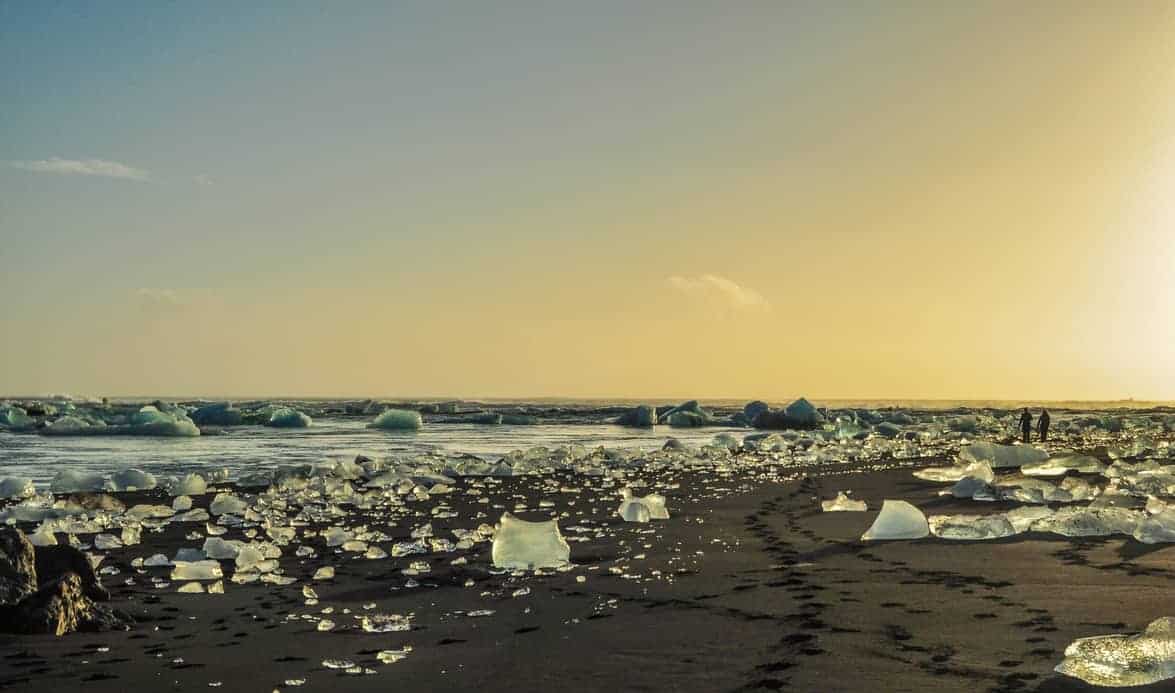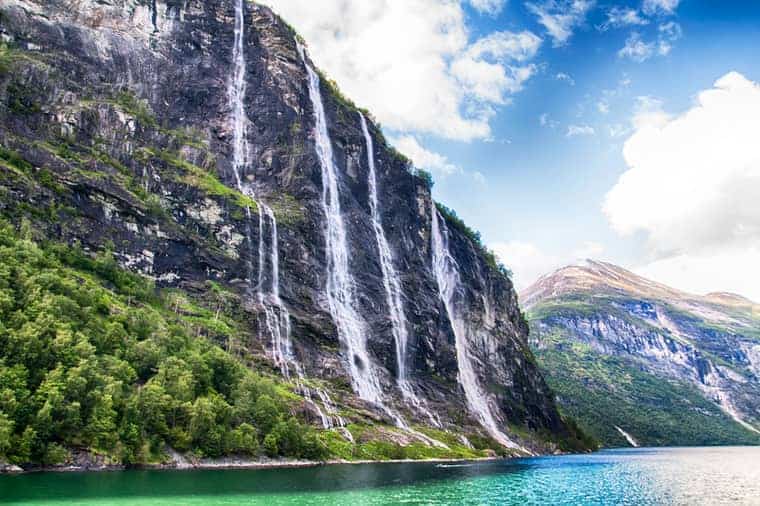The Viking era may be the most well-known period of Scandinavian history because so many people are interested in the Norse raiders from Northern Europe.
But where did the Vikings come from? Were they the first inhabitants of northern Europe? What was Scandinavia like before the Vikings?
There were people in Scandinavia long before the Viking era. The first visitors arrived at the end of the Ice Age approximately 10,000 years ago.
They were explorers, hunters, and fishermen. Some settled in the region to cultivate the land, raise families, and live in tribal communities.
The modern-day lands that the countries of Norway, Denmark, Sweden, Finland, and Iceland, call home were once under the ice.
When the frozen landscape thawed, a story began and thousands of years later it’s still being told.
The Vikings are an important part of Scandinavian history, but the story doesn’t start with them. Keep reading to learn more.
The Vikings have a fascinating history, but what was their fate? See Scandinavia Before the Vikings to learn more.

Viking descendants: 10,000-5,000 B.C.
Approximately 10,000 to 12,000 years ago, at the end of the last ice age, the first people stepped foot onto the newly-thawed surface of ancient Scandinavia. [1]
When the ice melted, channels of water carved their way through the land, and vegetation grew and spread from south to north.
Glaciers retreated, forests grew, and animals multiplied.
These early visitors to the newly-thawed Scandinavian region may have been looking for food, and perhaps pursuing animals like deer, birds, or fish.
These foragers were probably carrying spears, bows and arrows, knives, and other primitive weapons and tools. (Also see Why Are Vikings Associated with Axes?)
Though the ice was retreating northward, the region was still cold, dark, and gray. The first visitors didn’t have as much daylight to work with as they did further south in Europe.
The harsh environment of northern Europe discouraged widespread settlement in the region for centuries.
While European countries to Scandinavia’s south were experiencing the rise of various civilizations, kingdoms, and empires, the frigid climate and rugged geography of Scandinavia remained uninviting to most people.
The European lands to the south were warmer and flatter, which made growing crops easier and establishing settlements more manageable.
Nevertheless, over time, people groups began to appear in the region.
The Vikings were religious people. See Were the Vikings Christian? to learn more.

Who were the first Scandinavians?
Scandinavia’s story begins slowly. The obstacles in the natural environment proved formidable to most. Archaeological discoveries piece together a story that is largely incomplete.
Nevertheless, the fragments of history give people a glimpse into the dawn of Europe’s northern peninsula.
- The first people in Denmark after the Ice Age may have been hunters seeking reindeer around 10,000 B.C. Reindeer would eventually be important animals in Scandinavia, providing people with meat to eat, fur to keep them warm in the cold, and antlers that could be made into tools. (Also see The Vikings in Denmark: Get the Facts)
- The first people in Norway after the Ice Age may have been have come from the south, up the western coastline, around 8,000 B.C. Like the first explorers in Denmark, these visitors were probably hungry. Fishing was likely a focus on their effort, but hunting game that lived near the coast would likely have netted them meat as well.
- The ice melted in Sweden and Finland later than it did in Norway and Denmark. As the ice melted, the land rose, having been freed from the weight of the frozen water on top of it. The rising land creating lakes and channels through which water flowed and carved the land. People began to settle in Sweden around 6,000 B.C. and Finland even later.
Progression toward civilization, including regional kingdoms, local governments, and others aspects of a growing culture, was sparse for centuries.
Until more ice melted, the limitations of the first Scandinavians were significant.
As the region grew warmer, advancements were made. 3,000 B.C. marked a turning point.
The first agriculturalists made their entry upon the Scandinavian scene, with “slash-and-burn” farming in patches of the forest, semi-nomadic stock-keeping, and eventually the building of more or less permanent settlements in wood or wattle or daub.
Succesive improvements in pottery and toolmaking mark the arrival of several waves of immigrants from the south – or, in the case of Finaldn, from the east. [2]
The Vikings were similar to and different from other people groups in the Middle Ages. See Did Vikings have clans? to learn more.

Scandinavia’s earliest people groups
There were different people groups in ancient Scandinavia, though not a lot is known about them presently.
“In the case of Scandinavia the prehistoric period, known to us only through the often uncertain interpretation of sporadic archaeological finds, was of longer duration than in the more genial lands to the south.” [1]
Scientists continue to study these ancient Scandinavian people groups:
- The Maglemosian culture (approximately 9,000-6,000 BC): They fished, hunted, and used tools made of fish and bone.
- The Fornsa-Hensbacka culture (8,300-7,300 B.C.): see below
- The Kongemose culture (approximately 6,000-5,000 B.C.): They were hunters and used arrows and axes.
- The Nostret-Lihult cultures (approximately 6,000-3,000 B.C): They lived and hunted on the coasts of Norway and Sweden.
- The Ertebolle culture (approximately 5,000-4,000 B.C): They lived in Denmark and Southern Sweden. They fished, hunted, and made pottery.
These people groups may have been distant relatives of the Vikings:
“There is no convincing evidence of any later migrations into Scandinavia, so it seems likely that the Vikings were the direct descendants of these hunter-gatherers.” [2]
Forsna-Hensbacka people and culture
The earliest hunter-gatherers in ancient Scandinavia were likely members of what is known today as the Forsna-Hensbacka people group.
The approximate dates of existence for the Forsna-Hensbacka people group are 8,300-7,300 B.C. (Also see Traditional Viking Art: 7 Styles of the Period)
The names “Fosna” and “Hensbacka” describe two people groups in ancient Scandinavia that had so many similarities anthropologists know them as the “Fosna-Hensbacka” culture.
- “Fosna” is a word that describes ancient settlements on the coast of Northern Norway.
- “Hensbacka” is a word that describes ancient settlements of the coast of Western Sweden.
Another people group, called Komsa, is often considered part of this culture as well, though it shared fewer similarities with the Fosna-Hensbacka people.
- “Kosma” is a word that comes from a mountain in Northern Norway called Mount Komsa, which was used by 20th century archaeologists who discovered artifacts in the area.
The Fosna, Hensbacka, and Komsa were people groups of unknown origin, but their way of life lasted for millennia:
“It is meaningless to talk of nationality in those distant times, and idle to speak of race; but these hunters, fisherman, and food-gatherers from the south…these were the parent ‘Scandinavians,’ and their way of life, closely adapted to their surroundings, persisted for many thousands of years.” [3]
Environmental changes in northern Europe
Around 5,000 B.C, Northern Europe saw temperatures rise, perhaps the result of shifting ocean currents in the North Atlantic Ocean.
Though people explored the newly-unearthed land, there was not widespread settlement until later:
“Nevertheless, except in their most southern latitudes these lands were too inaccessible and relatively too infertile to attract much further immigration, so the extensive land-winning of this Late Neolithic period was in all probability achieved by the peoples who are known to us as Scandinavians.” [4]
These early Scandinavians were likely of mixed racial heritage, but they may have already had some of the physical characteristics that would become associated with the inhabitants of the region like blonde hair. [5] (Also see Did Vikings Have Long Hair?)
Bronze Age: 1500-500 B.C.
In the Bronze Age, the residents of Scandinavia participated in trade with countries in Southern Europe. They traded amber and fur among other things and received tin and copper among other things.
Trade increased the worth of the possessions for some Scandinavians, and less so for others who failed to acquire goods that they could neither grow nor make.
As the name of this period suggests, the weapons were made of bronze at this time in history. This showed advancement and new levels of sophistication.
Certain tools, like plows, horses, and boats, became commonplace.
As the ancient Scandinavians were able to utilize the natural resources around them their progress as a people grew exponentially. (Also see Why Did the Vikings Use Longboats?)
Also at this time, the land became more fertile and harvests were increasingly fruitful, which led to greater engagement with the sun god who provided these blessings.
Fertility rites were also commonly practiced and observed, as people celebrated the expansion of their people group and its culture.
500 B.C. – Christ
In the millennia before Christ, a cooling phase occurred in the region, which caused shifts in the clothing, dwellings, and growth of vegetation.
Certainly the climate, which had for about 2,000 years been drier than it is nowadays, became both wetter and colder, so that towards the north deciduous trees began to disappear and on the high ground the glaciers began to reform.
Clearly, the semi-nomadic population of northern hunters found its means of livelihood painfully restricted, whilst throughout Scandinavia more effort was required to provide adequate clothing and shelter. [5]
Trade decreased with people groups in the area surrounding the Mediterranean sea, as the Celts expanded their disruptive influence in the central region of Europe.
Obstacles in the natural environment and a lack of non-native resources proved challenging in these years.
This is also the first time that Mediterranean writers mention northern Europe and note its dark skies and constant rainfall.
The Roman Empire established trade with Scandinavia after the Celtic era declined.
Christ – 500 A.D.
In the early 2nd century, Roman coins, housewares, and art could be found in Scandinavian areas, Danish decor depicted scenes from the Iliad, suggestive of significant Greek influence.
The earliest known Runic inscriptions date to the 3rd century, it was used for hundreds of years. New settlements multiplied during this time period.
Relationships with neighboring people groups also increased, especially in Southern England and countries around the Mediterranean world.
The Roman writer Pliny mentions “Scandia,” a reference to the lands north of Denmark.
Other historians and writers, like Tacitus, mention people groups related to modern-day Sweden.
500 – 700/800 A.D.
This era set the scene for the Viking age. It was marked by increased hunger, a growing population, food insufficiency. It also saw further developments in weaponry and sailing.
Western Europe had grown into a time of relative peace and prosperity, as a result, riches were left unguarded. The Viking era began to bloom in the late 8th century A.D.
Northern Europe was unknown
For centuries, the Mediterranean world, which contained most of the continent’s population, knew little about the region north of present-day Germany, even though people had been there well before the Greeks and the Romans.
Scandinavia was more like another world to the residents around the Mediterranean Sea as opposed to an adjacent region on the same continent.
People were ignorant of, and perhaps disinterested in, the land belonging to modern-day Norway, Sweden, Denmark, Finland, and the islands in the Northern Atlantic ocean.
“Far into the first millennium of the Christian era, when events in other parts of Europe had been brought to some extent into focus by the labours of annalists and the first historians, the north remained a terra incognita to whose existence the civilised world was almost indifferent” [6].
The people groups that surrounded the Mediterranean Seas were the hub of commerce, politics, religion, and much more.
Europeans lands to the north were considered dark in the sense that they were pagan and there were also dark in the sense that they did not receive as much sunlight as other regions to the south.
8th century Scandinavia
The 8th century sets the stage for the rise of the Vikings and it’s the period of Scandinavian history in which they are not active or recalled.
The region was on the brink of an eruption of people, material goods, and conflict.
- Norway: In the 8th century, Norway is a conglomeration of tribes and small kingdoms. Districts amassed greater influence through the abundance of goods that they could grow or raise, for the purposes of consuming or trading.
- Denmark: Denmark’s conglomeration of tribes and small kingdoms was more united than Norway’s. Danes began stealing from their European neighbors to the south who had established trading activities with Christian and Muslim people groups around the Mediterranean Sea.
- Sweden and Finland: People groups in these countries didn’t advance as quickly as Norway and Denmark. They were less united as well, as their tribes were mostly still self-sufficient at this time.
While Central and Southern Europe had not targeted the people residing in Northern Europe in the 8th century, the Norse were targeting them.
The first Vikings took advantage of being ignored, as the distractions of others led to opportunities for them.
When the tide of Muslim conquest had been turned back from western Europe and Charlemagne was building his Frankish empire on Christian foundations, the north remained almost entirely out of the sphere of interest of civilized man. [7]
Yet while the rest of Europe slept, the first Vikings prepared.
Archaeological evidence from boats at this time, reveal that as Europeans struggled to control the other parts of the continent, the ancient Scandinavians were making rapid advances in relation to maritime technology.
The ships they built, and the speeds they reached, would become the subject of legend. They developed the ability to surprise their victims because of how fast they could arrive at their destinations.
Combine their seafaring advancements with their relentlessly brutal approach to combat and one has history in the making.
The Viking Age is born
What caused the Viking age to start? It’s known that the targets of their raids had great wealth, but that fact was not novel.
Did Scandinavians reach the point in their history and development that they were able to initiate and win a conflict with neighboring countries? Possibly. (Also see 15 Facts About Viking Women)
Historians know when the first Vikings started raiding, but there is debate about why they started then. Here are two common suggestions:
Overpopulation: This argument contends that Scandinavia was growing so rapidly, that there weren’t enough resources for them to sustain their way of life.
They needed more land, more resources, more slaves, and more women to marry Viking men and have children.
Overpopulation is the reason cited by some European historians from the Viking age.
Adventure: In writings from the time period that are most connected to the Vikings—the Scandinavian sagas—suggests that the Vikings were adventure-seekers, who wanted to explore the world and demonstrate the superiority of their way of life, and their fighting prowess, on the rest of the known world. (Also see 6 Reasons the Vikings Invaded Britain)
Whatever their driving purpose, their ships and seafaring ability helped them realize their ambitions.
Like the Vikings glided stealthily through the waters of Northern Europe at the end of the 8th century to sneak up on their English targets, their raids, in a sense, sneaked up on history, too, as the first words recorded about them come from an English author in the Anglo-Saxon Chronicle in 793 A.D.:
This year came dreadful fore-warnings over the land of the Northumbrians, terrifying the people most woefully: these were immense sheets of light rushing through the air, and whirlwinds, and fiery dragons flying across the firmament.
These tremendous tokens were soon followed by a great famine: and not long after, on the sixth day before the ides of January in the same year, the harrowing inroads of heathen men made lamentable havoc in the church of God in Holy-island, by rapine and slaughter. [8]
The Viking age had begun.
References:
[1] Source
[2] Ibid.
[3] Source
[4] Ibid.
[5] Derry, 5-7.
[6] Source
[7] Terry, p. 15
[8] Source
